Hot cereals: The tastiest, healthiest oatmeals and more
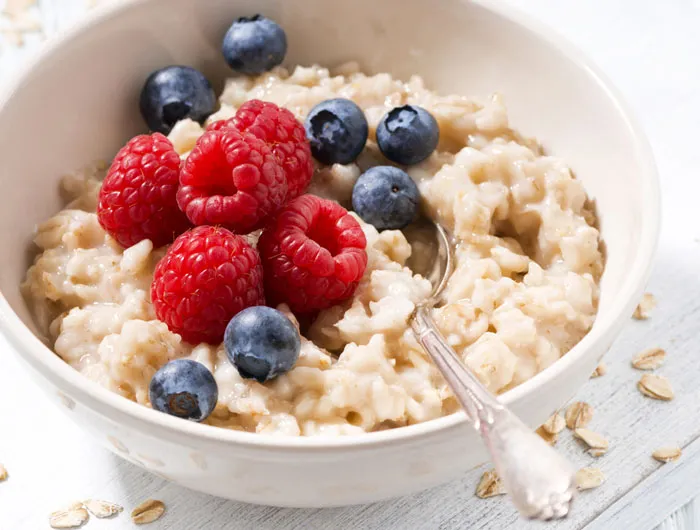
cook_inspire - stock.adobe.com.
Oatmeal is always a whole grain. But many single-serving packets of oatmeal and other hot cereals that line supermarket shelves are too sugary for a healthy breakfast and too low in protein and calories for a full meal. (Oatmeal’s 5 grams of protein per serving doesn’t make much of a dent in your 50-gram daily target.) Flavored instant packets can get pricey for just a small serving. And sometimes, you just want a new flavor, texture, topping…or a new kind of grain altogether. We’ve rounded up a bunch of healthy cereals that solve one (or more) of those morning meal problems. Enjoy!
This article comes from Nutrition Action. We don't accept any paid advertising or corporate or government donations. Any products recommended by Nutrition Action have been vetted by our staff of nutritionists and are not advertisements by the manufacturers.
1. Try quick steel-cut oats for more texture in less time

Here’s one way to pick your perfect oats. Ask yourself how much time you have to make breakfast on a busy morning. Depending on how the oats have been processed, cooking them runs the gamut from slow to speedy. Steel-cut oats have the thickest texture and the most chew, but they also take the longest to cook—about a half hour on the stovetop. (See “Oats: Slow to speedy.”)
But quick steel-cut oats from Quaker and many other brands take no more time than rolled (“old-fashioned”) oats to cook in the microwave or on the stovetop—about 3 to 5 minutes. They’re cut into smaller pieces than regular steel-cut oats, so you trade some texture for time saved. Tip: If you cook yours in the microwave, use a deep, wide bowl that’s larger than you’d think you need, so the oats don’t overflow.
If you prefer the hearty texture of regular steel-cut oats, try one of these strategies to simplify prepping them:
Cook a batch
In a medium pot, bring 4 cups of water to a boil, stir in 1 cup oats, reduce the heat to low, and simmer uncovered over low heat, stirring occasionally, for about 25-30 minutes, then refrigerate. Makes 4 servings. To reheat 1 serving, microwave with a splash of water and any fruit or other toppings.
Slow cook overnight
Spray the inside of a slow cooker with cooking spray, add 8 cups water and 2 cups oats, and cover and cook on low for 7-8 hours. Makes 8 servings.
Try breakfast bulgur
Newsflash: Bulgur—nutty-tasting whole-grain wheat—can go beyond its usual role in tabbouleh (a Middle Eastern bulgur salad). It can be ready for your fiber-rich breakfast bowl in half the time it takes to cook steel-cut oats, and it has no less fiber or protein (see “Whole grain vs. whole grain”). The “fine” kind of bulgur only needs a 10-to-15-minute soak in boiling water. A coarser or “medium” grind needs a simmer (check the package for instructions). Try serving cooked bulgur with cinnamon, apples or pears, and walnuts or pecans.
Oats: Slow to speedy
Hover over each type of oat to see what it is and how long it takes to cook.
2. Gluten-free? Go with gluten-free oats, teff, quinoa, or millet
Got celiac disease or non-celiac gluten sensitivity? Oats are naturally gluten-free, though they can be contaminated with gluten if they’ve been grown in the same fields—or processed on the same equipment—as wheat or other grains that naturally contain gluten. So if you need to avoid gluten, buy only oats that are labeled “gluten-free.” (To jump to a list of which products mentioned in this article are gluten-free, click here.)
And if you’re avoiding oats because of an allergy—or just looking for something new—you’re in luck. Three other gluten-free whole grains have roughly as much fiber (3 to 4 grams per 40-gram dry serving) and protein (4 to 6 grams) as a serving of oats. Any of them would be right at home in a breakfast porridge.
Teff

“This East African cereal grass originated in Ethiopia thousands of years ago and is the smallest grain in the world,” says the package of Bob’s Red Mill Teff. If you’re a fan of Ethiopian cuisine, you may have eaten teff flour, which is used to make the spongy flatbread injera.
Cooked whole teff turns out satisfyingly smooth, thick, and creamy. Think of it as fiber-rich whole-grain Cream of Wheat. Teff’s nutty-tasting flavor pairs well with dried fruits like raisins or chopped dates, toasted nuts like chopped walnuts or pecans, and a drizzle of sweetness from honey or maple syrup, if you like. It cooks in 15 minutes on the stovetop.
Tip: If the package tells you to rinse the teff before cooking it, use a coffee filter. The holes in many strainers for draining pasta or rinsing fruits or vegetables are too big to contain the tiny grain.
Quinoa
Compared to teff, quinoa’s texture is less porridge-y, and its taste is more neutral. That means your toppings can lean sweet or savory. To go savory, top a bowl of cooked quinoa (pronounced KEEN-wah) with a fried or hard-boiled egg, a few slices of avocado, and a vegetable or two (like raw or sautéed cherry tomatoes, baby kale or spinach, or scallions), plus a dash of hot sauce or a sprinkle of everything bagel seasoning. Quinoa cooks in 15 minutes on the stovetop.
Millet
Millet’s texture is like a slightly starchier, more porridge-y version of quinoa. The taste? Think corn grits, but with more texture and whole grain. (Grits are milled—that is, refined—corn.) Sweet or savory toppings will do. Millet cooks in 30 minutes on the stovetop.
Whole grain vs. whole grain
For each breakfast grain, here’s how much fiber, protein, and calories to expect from a typical 40-gram serving (about 1/4 to 1/2 cup dry).
| Calories | Fiber (g) | Protein (g) | |
| Oat bran | 150 | 7 | 7 |
| Bulgur | 140 | 5 | 5 |
| Oats (quick, rolled, or steel-cut) | 150 | 4 | 5 |
| Quinoa | 150 | 3 | 6 |
| Teff | 150 | 3 | 5 |
| Millet | 150 | 3 | 4 |
Source: Bob’s Red Mill (oat bran), USDA Food Data Central (other grains).
3. For more staying power, add a spoonful of seeds

A serving of most plain unsweetened oatmeals or other hot cereals has no more than 200 calories. That’s not much of a meal. For more staying power, you could top your bowl with milk or plant milk, fruit, and nuts. But don’t forget about seeds. Hello, taste, texture, healthy fats, and fiber!
Two seeds to try: chia and hemp. Simply stir a tablespoon or so into your cooked grains. You might need to add a splash of extra water, especially for thirsty chia seeds, which absorb water.
Chia seeds
They offer a bundle of nutrients like polyunsaturated (good) fats, zinc, iron, magnesium, and protein. Then there’s the fiber—an impressive 3 grams for every tablespoon.
Hemp seeds
Like chia, hulled hemp seeds (aka “hemp hearts”) pack in good fats, zinc, iron, and magnesium. And they’re a standout for protein—about 3 grams per tablespoon.
Easy as 1, 2, 3
Whole Foods’ 365 Super Seed Trio combines chia and hemp with ground flaxseed, another healthy-fat-and-fiber bonanza. Every tablespoon of the trio adds a few grams of fiber, protein, polys, and other nutrients to your oatmeal. It’s also likely to be cheaper than buying oatmeal blends that come with super seeds already mixed in. We paid $13 for a pound of the trio—about 45 tablespoons’ worth.
Tip: Once you open the bag, store it in the fridge or freezer to keep the seeds’ polyunsaturated oils fresh for longer.
Try an oatmeal blend
If you don’t want to keep seeds on hand, try an all-in-one blend like Trader Joe’s Unsweetened Instant Oatmeal Packets, Trader Joe’s Organic Rolled Oats with Ancient Grains & Seeds, or Purely Elizabeth Organic Original Superfood Instant Oatmeal. All three have oats, quinoa, and amaranth, plus flax and chia seeds. Added sugar? Zip.
4. Prefer a classic instant oatmeal packet? Upgrade yours

Many instant oatmeal packets come with at least two teaspoons of added sugar and, well, not many oats. Fortunately, Quaker has cracked the code on slashing sugar and keeping flavor.
If you’re after the traditional aroma and taste of instant Maple & Brown Sugar, Apples & Cinnamon, or Cinnamon & Spice, grab a Quaker Lower Sugar Variety Pack. Each packet has just 2 to 4 grams of added sugar, thanks to sweet-tasting monk fruit extract. (Heads up: We rate monk fruit extract as “caution” because it hasn’t been well tested in animals, but the fruit has been eaten in China for centuries.)
Tip: The packets are small, but you can add bulk with extra quick-cooking oats, a chopped apple, and/or a spoonful of peanut butter (let it sit on top of the hot oats to get melty before you swirl it around).
5. Two protein oatmeals with less sugar per packet
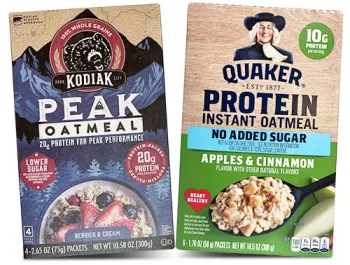
Many packets of instant oatmeal that add extra protein also add 2-1/2 to 3 teaspoons of sugar, but two new lower-sugar lines are raising the bar.
Kodiak Peak Oatmeal
Kodiak PeakBerries& Cream, Banana Nut, and Maple & Brown Sugar range from 1½ to 2 teaspoons (7 to 9 grams) of added sugar. And each 2.6 oz. serving of Peak is larger than typical instant oat packets, so you get enough protein (20 grams) for a full meal for only 300 calories. Kodiak bulks up its oats with added pea protein, milk protein, and chia seeds, and cuts the sugar with monk fruit extract.
Quaker No Added Sugar Protein Instant Oatmeal
So far, Quaker makes only one variety of No Added Sugar Protein Instant Oatmeal. Each 180-calorie packet of Apples & Cinnamon has an impressive 10 grams of protein (from the oats and added whey protein) with zero grams of added sugar (its 5 grams of sugar all come from dried apples). Monk fruit and stevia extracts make up the rest of the sweetness. How about a few more flavors, Quaker?
6. Plain protein oats are ready for your toppings
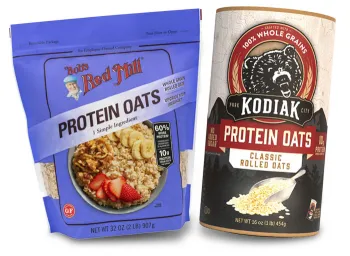
If you’re looking for plain unsweetened oats with roughly double the protein of regular oats (10 grams per serving), take your pick of Bob’s Red Mill Protein Oats, Kodiak Classic Rolled Protein Oats, or Quaker Protein Old Fashioned Rolled Oats.
Bob bumps up the protein by tinkering with the oat itself; the company’s Protein Oats are a special oat variety that’s been bred to be higher in protein. The other two add a little whey and pea protein (Kodiak) or soy protein (Quaker). None add sugar.
All three are also unflavored, so think of each as a blank canvas. Add your own fruit, nuts, seeds, spices, whatever.
Heads up: Because Kodiak’s and Quaker’s protein oats have added protein, make sure you shake up the tub or bag before you pour out a serving. Otherwise, much of the extra protein could end up at the bottom of the container.
You could also turn your own regular oats into protein oats. Just add protein from toppings or mix-ins. A few to consider (or see our longer list with calories):
- Plain Greek yogurt – about 15 grams per 2/3 cup
- Ultra-filtered milk – 13 grams per cup
- Dairy or soy milk – about 8 grams per cup
- Peanut butter – 4 grams per Tbs.
- Hemp seeds – 3 grams per Tbs.
7. Whole grains, fruits, nuts…the gang’s all in here

Some products really have the whole package: oats, fruit, nuts, protein, flavor. Bonus points if they come in a big multi-serving bag that lets you choose how much (or how little) you want to eat. Two picks that fit the bill:
Seven Sundays Protein Oats
The Wild Berry, Apple Cinnamon, and Maple Almond varieties of Seven Sundays Protein Oats come brimming with good stuff like almonds, flax seeds, chia seeds, dried fruit, and enough “upcycled oat protein” (oat flour left over from making oat milk) to hit at least 10 grams of protein per ½ cup (dry) serving. And the added sugar (6 to 8 grams) isn’t bad. But its convenience comes at a cost: We paid roughly $9 for a 16 oz. bag. That works out to $1 per serving.
Bob’s Red Mill Old Country Style Muesli
Bob’s Red Mill Old Country Style Muesli is a perennial favorite of ours for a reason. It’s chock full of yummy, nutrient-rich ingredients—we’re talking whole grains (wheat, rye, oats, triticale), seeds (sunflower, flax), nuts (almonds, walnuts), and dried fruit (dates, raisins). It has no added sugar. And you can eat it hot like oatmeal or cold like cereal or overnight oats. What’s more, Bob’s large 40 oz. bag comes at a nice price. We paid just $9 at Whole Foods Market. That comes to roughly 50 cents for each generous portion (twice the serving size listed on the bag’s Nutrition Facts label).
8. Never had oat bran? You may be surprised
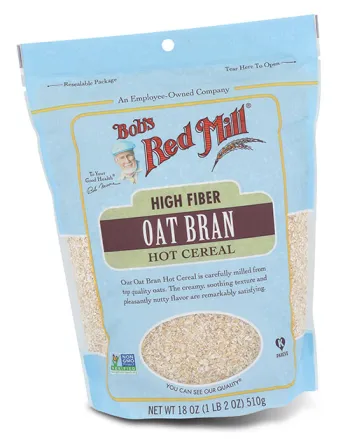
Why trade in your everyday oatmeal for an occasional bowl of hot oat bran? It’s not just that oat’s bran—its outer layer—has almost twice as much fiber as oatmeal and no less protein. Texture-wise, it’s a change of pace. If you’d rather have a smooth, creamy bowl of porridge than a hearty, chewy bowl of steel-cut oats every once in a while, give oat bran a try. And if you’re a fan of lower-fiber non-whole-grain hot cereals like Cream of Wheat or grits, you’ve got even more reason to switch.
9. Make your own instant oatmeal to save time and money
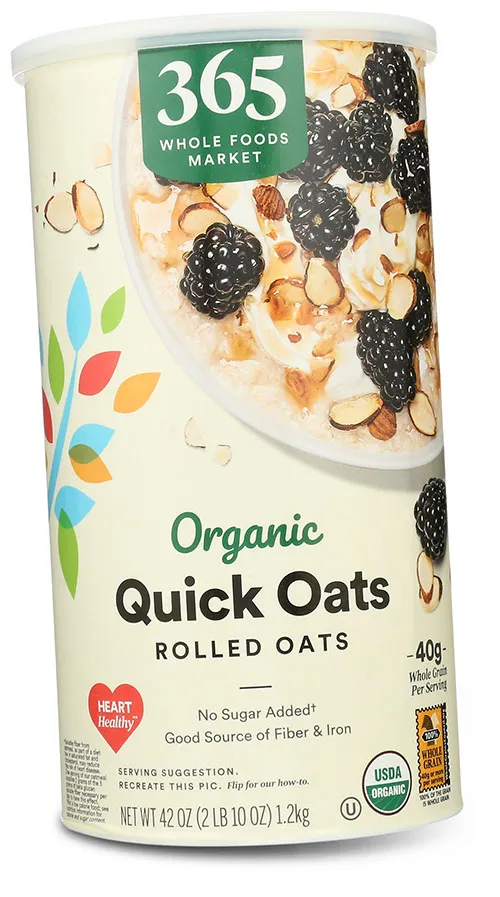
If you have a few minutes of prep time once a week, oats can be one of the cheapest healthy breakfasts around. For example, a 42 oz. canister of Whole Foods’ 365 Organic Quick Oats costs only $6—about 20 cents per serving. Ditto for 365 Organic Old-Fashioned Rolled Oats. A box of 365 Organic Maple & Brown Sugar Instant Oatmeal, on the other hand, will set you back three times that much per serving—about 60 cents a packet.
Even after adding your own spices, fruit, nuts, whatever, you can still come out ahead with a big tub. If you portion out servings of oats and toppings into reusable containers, you’ll ditch the packets’ excess packaging waste and set yourself up for a no-fuss breakfast. Just add water!
Toppings to try
Need to jazz up plain oats?Try one of these combos:
- Raisins or dates, walnuts or pecans, pumpkin spice
- Apricots (fresh or dried), toasted almonds
- Chopped apple or pear, cinnamon
- Blueberries (fresh or frozen), chia seeds, yogurt
- Banana, peanut butter (add a spoonful after heating or mix powdered peanut butter like PB2 in with your oats)
List of gluten-free products mentioned in this article
The following branded products mentioned in this article are labeled gluten-free:
- Bob’s Red Mill Teff
- Trader Joe’s Unsweetened Instant Oatmeal Packets
- Trader Joe’s Organic Rolled Oats with Ancient Grains & Seeds
- Purely Elizabeth Organic Original Superfood Instant Oatmeal
- Bob’s Red Mill Protein Oats
- Seven Sundays Protein Oats
The following generic grains and seeds mentioned in this article are naturally gluten-free, but check your package to confirm it’s labeled gluten-free before you buy:
- Teff
- Quinoa
- Millet
- Hemp seeds
- Chia seeds
Note: This article was originally published in September 2025. Its protein oats recommendations were updated in October 2025.
Support CSPI today
As a nonprofit organization that takes no donations from industry or government, CSPI relies on the support of donors to continue our work in securing a safe, nutritious, and transparent food system. Every donation—no matter how small—helps CSPI continue improving food access, removing harmful additives, strengthening food safety, conducting and reviewing research, and reforming food labeling.
Please support CSPI today, and consider contributing monthly. Thank you.
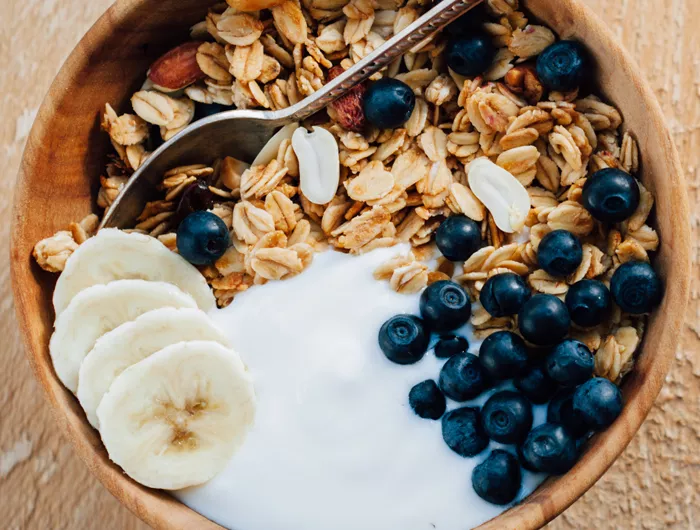
STAY IN TOUCH
Our best (free) healthy tips
Our free Healthy Tips newsletter offers a peek at what Nutrition Action subscribers get—healthy recipes, scrupulously researched advice about food of all kinds, staying healthy with diet and exercise, and more.

